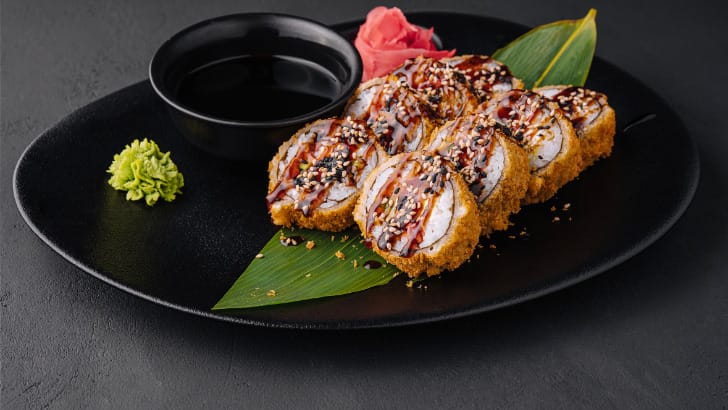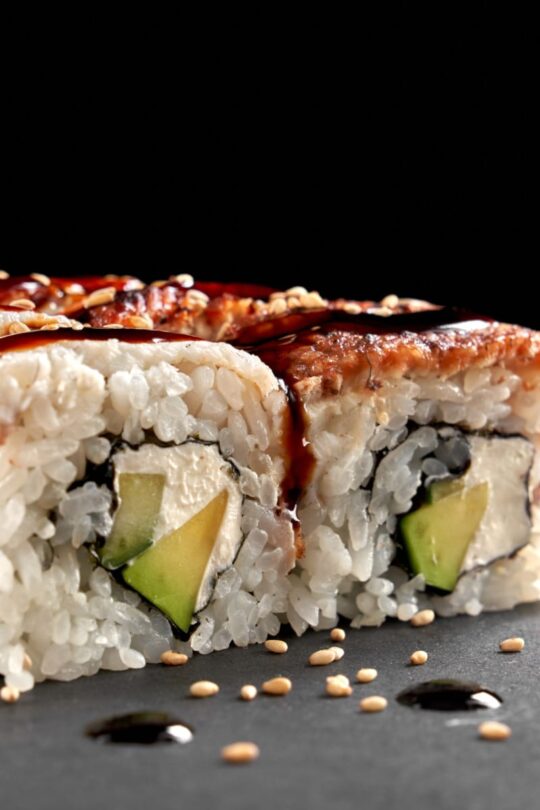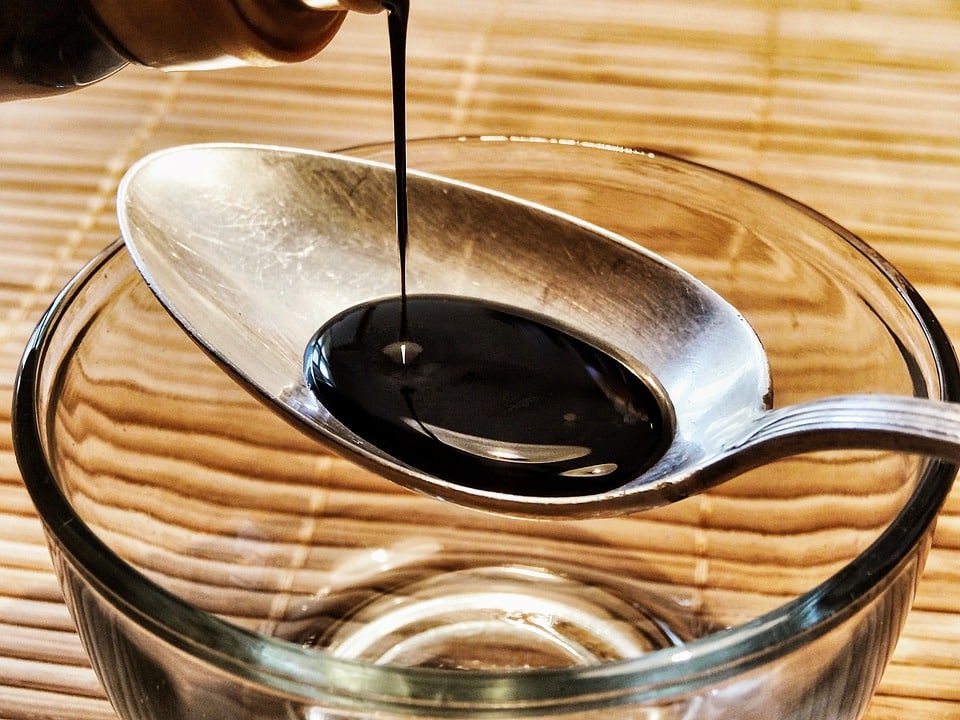Updated on April 4th, 2023
Nervous about trying eel sauce? Find out here what eel sauce tastes like.
What does eel sauce taste like?
Eel sauce, also known as unagi sauce, is a popular Japanese condiment. You’ll see it served with sushi and grilled fish.
The taste of eel sauce is complex. The first impression is sweetness, almost like caramel or molasses. That’s followed by a salty ocean flavor and a smoky, fishy earthiness. All-in, eel sauce has a rich, layered flavor that blends sweet and savory elements in a delicate way.
That complex flavor can enhance the taste of many dishes. It’s a must-try condiment if you like Japanese food and if you like experimenting in your own cooking.

Ingredients in eel sauce
The exact recipe for eel sauce varies by chef and brand, but the usual ingredients are: soy sauce, mirin, sake, sugar, and eel. It’s this interesting combination of ingredients that makes it tough to answer the question, what does eel sauce taste like?
Soy sauce
Soy sauce is the usual base of eel sauce. Soy sauce is made from fermented soybeans and wheat, and delivers a rich, umami flavor.
Mirin
Mirin is a sweet rice wine that carries a slightly tangy flavor. In eel sauce, the mirin balances some of soy sauce’s saltiness.
Sake
Sake is also a rice wine. It has a mild and slightly sweet flavor that enhances other flavors in eel sauce.
Sugar
Sugar is used to add sweetness to the sauce and balance out the saltiness of the soy sauce. Brown sugar is often used, to play into eel sauce’s rich, caramel-like flavor.
Eel
Eel is the star ingredient in eel sauce. Usually, it’s included in the sauce in the form of stock made from grilled eels. The eel delivers a smoky ocean flavor that’s hard to describe or replicate.
Some variations of eel sauce may also contain ginger or garlic to add extra flavor and depth to the sauce.
Health profile of eel sauce
Eel is a good source of protein, omega-3 fatty acids, and essential vitamins and minerals such as vitamin A, calcium, and potassium. Omega-3 fatty acids have anti-inflammatory properties. They may also reduce the risk of heart disease and stroke. Additionally, eel has been traditionally used in Chinese medicine to treat conditions such as joint pain and high blood pressure.
Soy sauce, a key ingredient in eel sauce, is a good source of protein, iron, and antioxidants. It also contains soy isoflavones, which may help reduce the risk of breast cancer and improve bone health.
That’s the good news. The bad news is that eel sauce is typically high in sodium and sugar. Sodium and sugar consumed in excess are associated with high blood pressure and obesity. For that reason, it’s smart to use eel sauce in moderation and to balance it out with other healthy ingredients and dishes.
Eel sauce uses in cooking
Now that we’ve answered to what does eel sauce taste like, here are some dishes that go well with this interesting condiment.
Sushi

Eel sauce is a popular topping for sushi rolls, especially those that contain grilled eel (unagi). It adds a sweet and savory flavor that pairs well with the other ingredients in the roll.
Grilled meats
Eel sauce also makes a nice marinade or glaze for grilled meats such as chicken or pork.
Seafood dishes
You can use eel sauce as a topping for grilled or fried fish, or as a dipping sauce for shrimp or scallops. The umami-rich flavor pairs well with the natural sweetness of seafood.
Noodle dishes
Try using eel sauce to flavor noodle dishes such as udon or soba. The rich, savory flavor goes nicely with a hearty broth and noodle.
Vegetarian dishes
You can also use eel sauce to add flavor to vegetarian dishes such as tofu or vegetable stir-fry.
Overall, eel sauce is a versatile condiment that lends a sweet, salty, and smoky flavor.
How to make eel sauce
If you don’t have eel sauce on hand, you can make a reasonable substitute. You’ll find many wonderful eel sauce recipes around the web.
To make a quick-and-dirty eel sauce, mix 2 parts soy sauce, 2 parts mirin, 1 part sake, and 1 part granulated or brown sugar. Bring the mixture to a boil over medium-high heat, while stirring so the sugar dissolves. Let it thicken — it should reduce by half. Then add in 1 part eel stock — or use fish stock if you can find the eel variety. Simmer for another 5 or 10 minutes.
Eel sauce FAQs
Here are some frequently asked questions (FAQs) about eel sauce.
What is eel sauce?
Eel sauce, aka unagi sauce, is a sweet and savory sauce used in Japanese cuisine as a condiment for sushi rolls, grilled meats, seafood dishes, noodle dishes, and more. It’s made from soy sauce, two types of rice wine, sugar, and eel or fish stock.
Does eel sauce contain eel?
While eel sauce is named after eel, it doesn’t always contain eel as an ingredient. The best eel sauces are made with eel stock or at least fish stock. This adds a more pronounced flavor.
Is eel sauce vegan or vegetarian?
Most eel sauces contain animal-based ingredients — namely eel or fish stock. So they are unsuitable for vegans and vegetarians. You could make a vegan eel sauce by using vegetable stock instead of fish stock.
Can I use eel sauce as a substitute for soy sauce?
While eel sauce contains soy sauce as an ingredient, it’s not a direct substitute for soy sauce. Eel sauce is thicker and sweeter than soy sauce, so it’s best used as a condiment or flavoring rather than a primary seasoning.
How long does eel sauce last?
Eel sauce can be stored in an airtight container in the refrigerator for up to a month. If the sauce becomes too thick, you can thin it out with a little bit of water or more mirin.
Where can I buy eel sauce?
You can buy eel sauce at Asian grocery stores or online. Some Japanese restaurants may also sell their homemade eel sauce for customers to take home.
